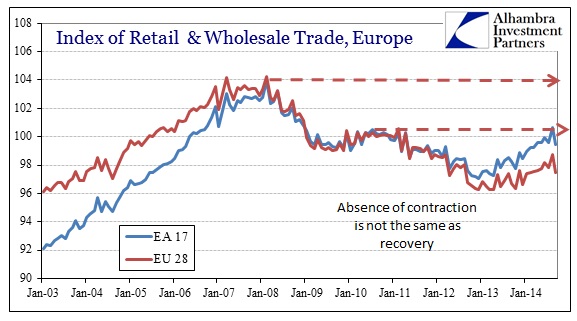
Home » Posts tagged 'gdp' (Page 28)
Tag Archives: gdp
Consumers Simply Never Showed Up | Alhambra Investment Partners – We Are Different.
Consumers Simply Never Showed Up | Alhambra Investment Partners – We Are Different..
The largest calendar segments of the retail universe are back-to-school followed closely by Christmas. The peak month for back-to-school is August which is usually the third or fourth biggest month of the year in terms of raw retail sales; with October right behind as Christmas retailing ramps up. September, which falls in between back-to-school and Christmas (at least historically), was relatively decent this year (4.46%) given the low standard of the post-2012 economy, but August was a plain mess which was far more important. Y/Y growth in August (ex autos) was just 2.5% which is so far below the 6-9% that “should” be evident in a recovery as to warrant some other classification.
That left retailers wondering if August was the aberration or September. With October’s figures having been released, unfortunately the August pattern has shown up at the start of the Christmas season as whatever happened to “boost” September was gone by the following month. The most important part of the retail calendar kicked off with all of 2.36% nominal growth over October 2013 – a month that inaugurated, at least to that point, the slowest Christmas season since 2009. In comparison, October 2013 saw 3.17% nominal growth, which is why retailers might want to start worrying (apart from auto dealers, of course).
…click on the above link to read the rest of the article…
Not Just The Franc Showing Euro Concerns | Alhambra Investment Partners – We Are Different.
Not Just The Franc Showing Euro Concerns | Alhambra Investment Partners – We Are Different..
With Europe reporting GDP, reactions have been somewhat varied. In some places, it was taken as not as bad as feared, while others were downright cheered by a lack of total collapse, as if that is now the standard for economic progress. Since GDP tends to be noisy in the short run, the major components, the economic base, continues to show anything but more of the same. There was nothing, to my mind, in the GDP report that indicated an inflection away from stagnation or slight decline. That is perfectly in-line with the trend that has unfortunately developed since midyear, pushing the ECB toward outward desperation.
The most striking aspect of the European economy post-2007 has been lower cycle peaks at every juncture. In industrial production and trade, the “recovery” after the initial blast of the Great Recession never came close to matching pre-crisis levels. Now after another “cycle”, the peak is yet again below this time even 2011. What we see, then, is no recovery at all but rather an ebb and flow in an otherwise downward direction toward full-scale depression.
…click on the above link to read the rest of the article…
The Scariest Number Revealed Today: $1.114 Trillion In Eurozone Bad Debt | Zero Hedge
The Scariest Number Revealed Today: $1.114 Trillion In Eurozone Bad Debt | Zero Hedge.
As we previously reported, the ECB’s latest stress test was once again patently flawed from the start. Why? Because as we noted earlier, in its most draconian, “adverse” scenario, the ECB simply refused to contemplate the possibility of deflation. And here’s why. Buried deep in the report, on page 75 of 178, is the following revelation which contains in it the scariest number presented to the public today.
Due to the fact that on average banks’ internal definitions were less conservative than the simplified EBA approach, the application of the simplified approach led to an increase in NPE stock of €54.6 billion from €743.1 billion to €797.7 billion. The CFR and the projection of findings led to an additional increase in NPE of €81.3 billion, resulting in a total increase €135.9 billion to €879.1 billion of post-CFR NPEs across the participating banks as a result of the AQR. The impact of the application of the EBA simplified approach and the credit file review on the stock of NPEs varied amongst debtor geographies, with overall increases among SSM debtor geographies ranging from 7% to 116%.
…click on the above link to read the rest of the article…
Van Hoisington And The Fed’s Bubble: “Overtrading” And “Discredit” Always End In “Revulsion” | Zero Hedge
Excerpted from Hoisington Investment Management’s Quarterly Outlook,
via Van Hoisington and Lacy Hunt:
The U.S. economy continues to lose momentum despite the Federal Reserve’s use of conventional techniques and numerous experimental measures to spur growth. In the first half of the year, real GDP grew at only a 1.2% annual rate while real per capita GDP increased by a minimal 0.3% annual rate. Such increases are insufficient to raise the standard of living, which, as measured by real median household income, stands at the same level as it did seventeen years ago.
…
Asset Bubbles
Historically, in our judgment, the most important authority on the subject of asset bubbles was the late MIT professor Charles Kindleberger, author of 20 books including the one of the greatest books on capital markets Manias, Panics and Crashes (1978). He found that asset price bubbles depend on the growth of credit. Atif Mian (Princeton) and Amir Sufi (University of Chicago) provided confirmation for Kindleberger’s pioneering work and expanded on it in their 2014 book House of Debt. Chapter 8, entitled “Debt and Bubbles,” contains the heart of their insights. Mian and Sufi demonstrate that increasing the flow of credit is extremely counterproductive when the fundamental problem is too much debt, and excessive debt can fuel asset bubbles.
…click on the above link to read the rest of the article…
Oil Shocks And The Global Economy
Oil Shocks And The Global Economy.
Here I re-tread a well-trodden path, but with recent events in the oil market I thought a brief recap might be timely.
I begin with a photographic illustration of a typical US demand response to the tripling of oil prices that occurred during the first “oil shock” in 1974:

Demand response after a tripling of oil price, USA, 1974
Those long lines of gas-guzzlers were indeed a demand response, but not to the oil price increase. They were a reaction to the nationwide shortage of gasoline caused by the oil embargo that accompanied it. Americans, like George Patton’s tanks during the Normandy breakout, just gotta have gas. And still do.
Fluctuations in oil price, particularly “oil shocks” are nevertheless believed to have had a major impact not only on the US economy but on the global economy as a whole since 1974, and here we will revisit some basic macroeconomic data to see how well this contention holds up.
…click on the above link to read the rest of the article…
Activist Post: Updated Secret Trans-Pacific Partnership Agreement (TPP)
Activist Post: Updated Secret Trans-Pacific Partnership Agreement (TPP).
WikiLeaks has released a second updated version of the Trans-Pacific Partnership (TPP) Intellectual Property Rights Chapter. The TPP is the world’s largest economic trade agreement that will, if it comes into force, encompass more than 40 per cent of the world’s GDP. The IP Chapter covers topics from pharmaceuticals, patent registrations and copyright issues to digital rights. Experts say it will affect freedom of information, civil liberties and access to medicines globally. The WikiLeaks release comes ahead of a Chief Negotiators’ meeting in Canberra on 19 October 2014, which is followed by what is meant to be a decisive Ministerial meeting in Sydney on 25–27 October.
Despite the wide-ranging effects on the global population, the TPP is currently being negotiated in total secrecy by 12 countries. Few people, even within the negotiating countries’ governments, have access to the full text of the draft agreement and the public, who it will affect most, none at all. Large corporations, however, are able to see portions of the text, generating a powerful lobby to effect changes on behalf of these groups and bringing developing country members reduced force, while the public at large gets no say.
…click on the link above to read the rest of the article…
Fuzzy Numbers – Crash Course Chapter 18 | Peak Prosperity
Fuzzy Numbers – Crash Course Chapter 18 | Peak Prosperity.

Shutterstock
Fuzzy Numbers – Crash Course Chapter 18
How we’re deluding ourselves with bad data
Friday, October 17, 2014, 9:58 PM
Chapter 18 of the Crash Course is now publicly available and ready for watching below.
What if it turned out that our individual, corporate and government decision-making was based on misleading, if not provably false, data?
As we detail in this latest chapter of the Crash Course series, that’s exactly the case today with the key indicators (inflation, GDP, employment, deficits, etc) our central planners are using to guide the future of the global economy.
The cumulative effect of all this statistical sleight of hand serves only to make things seem rosier than they actually are. If this is not lying to ourselves, then “deluding ourselves” is the next best term.
Keep this self-deception in mind when you next read about how “our robust economy is still expanding”.
We are now in the midst of a worldwide debt orgy, dangerous asset bubbles, the beginning waves of boomer retirements – and solid, credible information is what we need as a beacon to find our way out.
…click on the link above for the rest of the article…






